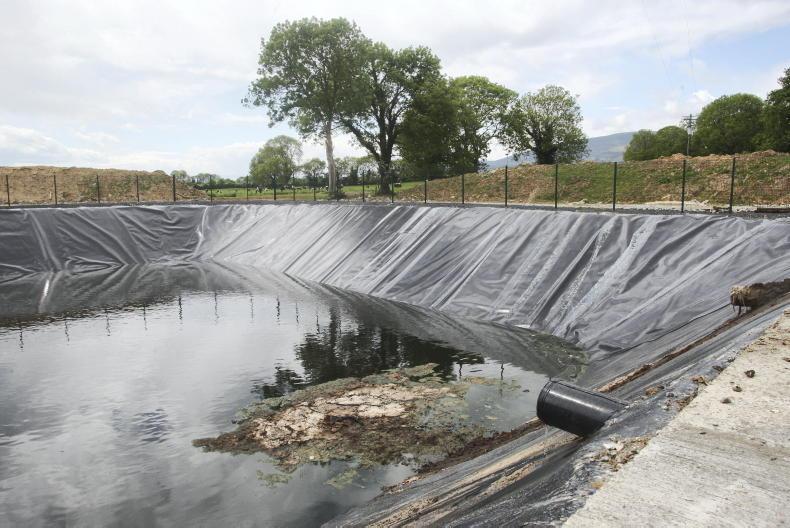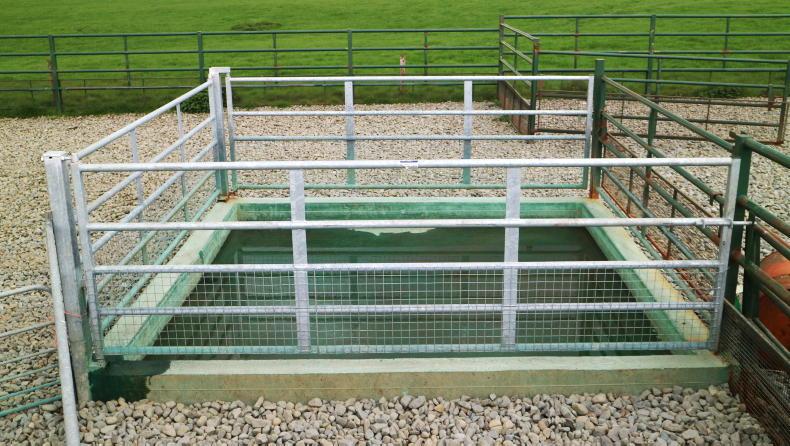Many farmers are watching closely for the impending release of Ireland’s Nitrates Action Programme consultation document, with potential changes to slurry storage featuring high on the list of reader queries received in recent weeks.
This week, we have addressed some of these queries based on the information we know so far and we will bring you further details as they come to light.
Q:
Aidan Brennan had an article a couple of weeks ago saying that it is likely that there will be new bands for organic nitrogen excretion rates for lower-yielding cows producing less than 5,500l per year and higher organic nitrogen levels for high-yielding cows producing greater than 7,000l per year.
I am in the middle of planning a new cubicle shed and tank and I am wondering if the slurry storage requirement per week will also change for the higher-yielding cows I have?
A: The full details of the nitrates consultation document should be announced imminently. This is just a consultation document as part of Ireland’s review of our Nitrates Action Programme (NAP), so it will be some months yet before any concrete decisions are made. One would expect, however, that if the organic nitrogen excretion levels increase or decrease, these changes will feed directly into slurry storage requirements.
The increase in the annual organic nitrogen excretion levels to 89kg N on 1 January as part of a midterm review of the NAP did not translate across to an increase in the weekly figure of 0.33m3 required for a dairy cow. However, it is reasonable to assume that any longer-term changes introduced on nitrogen excretion levels will also affect slurry storage requirements. A move in organic nitrogen excretion levels from 85kg to 89kg would bring about a pro-rata increase of 0.0155m3 per week.
Leaving weekly storage rates aside, one change which is reported as being on the cards is the start of the prohibited slurry spreading application period being brought forward from 15 October to September. As such, and taking into account other pressures which may be introduced on managing organic manures, soiled water etc, it would be prudent to provide extra capacity in any tank currently being designed. It will be far cheaper to increase slurry storage as part of a new build as opposed to returning at a later date and having to undertake a new development.
Q:
Following on from this question (above), is a requirement to roof all external slurry tanks likely to be included in the nitrates review?
A: Discussions regarding the covering of external slurry tanks is included in the Government’s Ag Climatise report as opposed to the NAP. The report states that all new external slurry stores must be covered from January 2022 and all existing external slurry stores must be covered by the end of 2027.
There is fair bit of confusion on this subject, with many farmers concerned that they will be required to invest significant sums in erecting a roof or robust physical cover over an external tank to direct rainfall away. This measure, however, is not related to soiled water and is designed to reduce ammonia losses in stored slurry.

There are a number of covers on the market that sit on top of the slurry and rise and fall with the level of liquid in the tank.
The rate at which gases such as ammonia are released from slurry is influenced by air speed over the slurry. Therefore, the likely cover required is one that can prevent air contact with slurry. There are numerous covers on the market, with these relatively common in the UK and US.
Some work on the premise of the cover sitting on top of the slurry and rising and falling as the level within the tank changes. These are most suitable to lagoon-type storage, where there is a vast area requiring a cover and a rigid structure is not possible.
Another option being trialled is the addition of balls which float on top of the liquid and prevent air contact. This technology is being used in the US in water tanks to prevent water being lost through evaporation.
Other designs for covering smaller overground circular tanks feature a more rigid type of cover, with some farmers who are likely to be tight on slurry storage considering investing in a roof structure to prevent rainfall from entering the tank.
The Department has not released any specifications yet on what type of covers will be required and if external slatted tanks will already be providing sufficient protection.
Q:
I am installing a new sheep handling unit and planning on constructing a batch footbath myself in concrete. What things do I need to keep in mind or am I mad to be thinking of doing so and better off buying a mobile unit?
A: There are numerous advantages and disadvantages, with the decision boiling down to handler preference. As is the case in designing a livestock handling unit or housing for that matter, I would consider it a vital step to visit a few units and see some options in practice. This will deliver much more than reading specifications, brochures, etc.
Fixed footbath units can work well as part of a sheep handling unit where they can fit into the overall design and work well with the normal flow of sheep.
Many people build the unit next to the exit from the sheep race, providing an option to footbath animals or exit the unit via an alternative route.
Some farmers also install a footbath along the floor of the race but this is generally not a good option as it can make it more difficult to fill the race and is messier for working with sheep. Where this has been the option in modern designs, it has often taken the form of a double-sided race or optimally two races with a walkway down the centre.

Batch footbaths should be located to work with the normal flow of sheep around the unit.
For optimum efficiency, the unit should be capable of holding the number of sheep in the holding pen along with providing a little extra capacity to make it easier to fill the unit. This will allow you to work on sheep in the race, transfer them to the footbath and leave them there while carrying on working on the next batch.
Teagasc adviser Edward Egan has undertaken significant research in the area of designing handling units and has put together an extensive manual which can be found by clicking here.
The guide includes a recommended pen size for flocks of a varying size and this is detailed in Table 1.
The guide states: “The size of the footbath is seen as a compromise between the cost of filling it with solution, hours spent footbathing and stand-in time. Bigger footbaths cost more to fill but reduce hours worked. Larger footbaths can also allow longer stand-in times.”
One difficulty which often arises with locating the footbath next to the race exit is having a pre-wash section to clean the hooves of sheep before entering.
The unit should be capable of being filled, emptied and cleaned regularly. Emptying can be aided where the unit is being constructed next to a tank and a bung and outflow pipe can be fitted to collect the solution.
This is an area of growing concern given environmental pressures and the importance of handling chemicals correctly.
Criteria
The other main criteria to consider is to build the unit with a depth of 100mm to 125mm and to design the entry and exit points in the floor (sloped or bevelled edge) to prevent foot injuries and the entrance and exit widths to promote smooth flow of sheep.
With regards purchasing a batch mobile unit, this provides an option to treat animals at different locations, plus it can work better where trying to fit a batch unit into an existing handling unit.
The most common mobile batch unit measures 3m in length by 1m wide but other units can be specially designed.
One downside to these mobile units, where not set into the ground, is that sheep have to raise their legs to enter the unit but where being installed in a semi-permanent manner, there are options to install ramps to get over this issue.
Many farmers are watching closely for the impending release of Ireland’s Nitrates Action Programme consultation document, with potential changes to slurry storage featuring high on the list of reader queries received in recent weeks.
This week, we have addressed some of these queries based on the information we know so far and we will bring you further details as they come to light.
Q:
Aidan Brennan had an article a couple of weeks ago saying that it is likely that there will be new bands for organic nitrogen excretion rates for lower-yielding cows producing less than 5,500l per year and higher organic nitrogen levels for high-yielding cows producing greater than 7,000l per year.
I am in the middle of planning a new cubicle shed and tank and I am wondering if the slurry storage requirement per week will also change for the higher-yielding cows I have?
A: The full details of the nitrates consultation document should be announced imminently. This is just a consultation document as part of Ireland’s review of our Nitrates Action Programme (NAP), so it will be some months yet before any concrete decisions are made. One would expect, however, that if the organic nitrogen excretion levels increase or decrease, these changes will feed directly into slurry storage requirements.
The increase in the annual organic nitrogen excretion levels to 89kg N on 1 January as part of a midterm review of the NAP did not translate across to an increase in the weekly figure of 0.33m3 required for a dairy cow. However, it is reasonable to assume that any longer-term changes introduced on nitrogen excretion levels will also affect slurry storage requirements. A move in organic nitrogen excretion levels from 85kg to 89kg would bring about a pro-rata increase of 0.0155m3 per week.
Leaving weekly storage rates aside, one change which is reported as being on the cards is the start of the prohibited slurry spreading application period being brought forward from 15 October to September. As such, and taking into account other pressures which may be introduced on managing organic manures, soiled water etc, it would be prudent to provide extra capacity in any tank currently being designed. It will be far cheaper to increase slurry storage as part of a new build as opposed to returning at a later date and having to undertake a new development.
Q:
Following on from this question (above), is a requirement to roof all external slurry tanks likely to be included in the nitrates review?
A: Discussions regarding the covering of external slurry tanks is included in the Government’s Ag Climatise report as opposed to the NAP. The report states that all new external slurry stores must be covered from January 2022 and all existing external slurry stores must be covered by the end of 2027.
There is fair bit of confusion on this subject, with many farmers concerned that they will be required to invest significant sums in erecting a roof or robust physical cover over an external tank to direct rainfall away. This measure, however, is not related to soiled water and is designed to reduce ammonia losses in stored slurry.

There are a number of covers on the market that sit on top of the slurry and rise and fall with the level of liquid in the tank.
The rate at which gases such as ammonia are released from slurry is influenced by air speed over the slurry. Therefore, the likely cover required is one that can prevent air contact with slurry. There are numerous covers on the market, with these relatively common in the UK and US.
Some work on the premise of the cover sitting on top of the slurry and rising and falling as the level within the tank changes. These are most suitable to lagoon-type storage, where there is a vast area requiring a cover and a rigid structure is not possible.
Another option being trialled is the addition of balls which float on top of the liquid and prevent air contact. This technology is being used in the US in water tanks to prevent water being lost through evaporation.
Other designs for covering smaller overground circular tanks feature a more rigid type of cover, with some farmers who are likely to be tight on slurry storage considering investing in a roof structure to prevent rainfall from entering the tank.
The Department has not released any specifications yet on what type of covers will be required and if external slatted tanks will already be providing sufficient protection.
Q:
I am installing a new sheep handling unit and planning on constructing a batch footbath myself in concrete. What things do I need to keep in mind or am I mad to be thinking of doing so and better off buying a mobile unit?
A: There are numerous advantages and disadvantages, with the decision boiling down to handler preference. As is the case in designing a livestock handling unit or housing for that matter, I would consider it a vital step to visit a few units and see some options in practice. This will deliver much more than reading specifications, brochures, etc.
Fixed footbath units can work well as part of a sheep handling unit where they can fit into the overall design and work well with the normal flow of sheep.
Many people build the unit next to the exit from the sheep race, providing an option to footbath animals or exit the unit via an alternative route.
Some farmers also install a footbath along the floor of the race but this is generally not a good option as it can make it more difficult to fill the race and is messier for working with sheep. Where this has been the option in modern designs, it has often taken the form of a double-sided race or optimally two races with a walkway down the centre.

Batch footbaths should be located to work with the normal flow of sheep around the unit.
For optimum efficiency, the unit should be capable of holding the number of sheep in the holding pen along with providing a little extra capacity to make it easier to fill the unit. This will allow you to work on sheep in the race, transfer them to the footbath and leave them there while carrying on working on the next batch.
Teagasc adviser Edward Egan has undertaken significant research in the area of designing handling units and has put together an extensive manual which can be found by clicking here.
The guide includes a recommended pen size for flocks of a varying size and this is detailed in Table 1.
The guide states: “The size of the footbath is seen as a compromise between the cost of filling it with solution, hours spent footbathing and stand-in time. Bigger footbaths cost more to fill but reduce hours worked. Larger footbaths can also allow longer stand-in times.”
One difficulty which often arises with locating the footbath next to the race exit is having a pre-wash section to clean the hooves of sheep before entering.
The unit should be capable of being filled, emptied and cleaned regularly. Emptying can be aided where the unit is being constructed next to a tank and a bung and outflow pipe can be fitted to collect the solution.
This is an area of growing concern given environmental pressures and the importance of handling chemicals correctly.
Criteria
The other main criteria to consider is to build the unit with a depth of 100mm to 125mm and to design the entry and exit points in the floor (sloped or bevelled edge) to prevent foot injuries and the entrance and exit widths to promote smooth flow of sheep.
With regards purchasing a batch mobile unit, this provides an option to treat animals at different locations, plus it can work better where trying to fit a batch unit into an existing handling unit.
The most common mobile batch unit measures 3m in length by 1m wide but other units can be specially designed.
One downside to these mobile units, where not set into the ground, is that sheep have to raise their legs to enter the unit but where being installed in a semi-permanent manner, there are options to install ramps to get over this issue.








 This is a subscriber-only article
This is a subscriber-only article










SHARING OPTIONS: